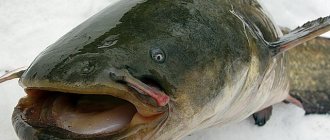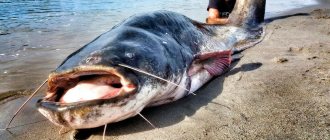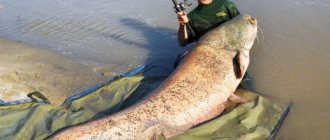Origin of the species and description
Photo: Som
Catfish belong to the ray-finned fish - the first representatives of this class appeared in the Devonian period, about 390 million years BC. Gradually they settled over larger and larger territories, and new groups and families were formed. The order of catfish is quite ancient - this is confirmed by many features of its representatives. So, among them there are species with spines on the head and fins, or with dermal teeth similar to those that sharks have.
Video: Catfish
Another important feature indicating the antiquity of catfish is the presence in the skull of some of them of a pineal opening, the same as in the lobe-finned or extinct lobe-finned Osteolepis - it is intended for a light-sensitive organ and is not typical for other fish. Catfish are related to characins, cyprinids and gymnotids - they all originated from one original genus, the division occurred in the Cretaceous period, after which this genus became extinct, and they continued to develop. Catfishes retain more archaic features.
The order includes the catfish family, which includes about a hundred species. The most characteristic of them is considered to be the common catfish - it will be discussed further. It was described by Calus Linnaeus in 1758, the scientific name is Silurus glanis.
Interesting fact: Legends about man-eating catfish are associated with the finds of human bones, as well as rings and parts of clothing in the stomachs of giant individuals. Most likely, the catfish simply ate already dead bodies that ended up in the river - there are no reliably recorded cases of them killing people.
Closely related species of catfish
The common or European catfish belongs to the genus Soma, family Catfish, order Catfish. The order Catfish includes 40 families. The Catfish family includes about 11-12 genera and about 97-100 species. The genus Soma includes 14 species. The closest related species to the European catfish are the Soldatov's catfish and the Amur catfish. In addition to them, on the territory of our country there are Channel catfish and American catfish, which are also included in the order Catfish, but belong to the family of Iktalur catfish.
Som Soldatova
(Silurus soldatovi) is a large fish reaching a length of up to 3 meters and a weight of up to 80 kg. Inhabits the Amur River basin, the Ussuri River and Lake Khanka. In appearance, size and color it is similar to the common catfish. Its back and sides are gray, with brown streaks, and its belly is light. Eats fish. Hunts at night. In the fall it goes to the depths, where it spends the entire winter without feeding. Reaches sexual maturity at 4 years. Spawning of Soldatov's catfish occurs in June-July, in coastal thickets. Soldatov's catfish is considered a rare fish; its numbers are constantly declining, which is why it is listed in the Red Book of the Russian Federation.

Amur catfish
(Parasilurus asotus) lives in Japan, China and Korea. In 1933, the Amur catfish was released into the rivers of Primorye, where it took root and multiplied. Found in Lake Baikal. The length of the Amur catfish is up to 1 meter, weight 6-8 kg. The body color of the Amur catfish is dark green, the belly is light. Prefers to settle in standing or bodies of water with weak currents. In summer it goes into channels, floods and the coastal zone. In autumn it goes deeper. It feeds on small fish, mollusks, frogs and crayfish. Hunt from ambush in the evening and at night. Reaches sexual maturity by 4 years. Spawning occurs from late May to July. It lays eggs on aquatic plants. The Amur catfish is widely fished; its meat is highly prized for its taste and low bone count.
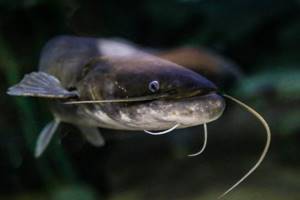
Channel catfish
(Ictalurus punctatus) is a fish of the Ictaluridae family. Lives in the USA, southern Canada, northern Mexico. The body length of channel catfish is from 60 to 130 cm, maximum weight is 4.5-9 kg. The body color is bluish-olive, gray, black, with spots on the sides, the belly is light. It feeds on fish, shellfish, insects, frogs, crayfish, and small mammals.
You may be interested in: Norstream Dynamic spinning rod
The most common catfish in North America, about 8 million American anglers fish for channel catfish. Since 1972, channel catfish began to be bred in Russia, in the Krasnodar Territory. From the ponds, the channel catfish entered the rivers of the Don and Kuban systems. Channel catfish are bred in ponds in the Moscow region and the Urals.
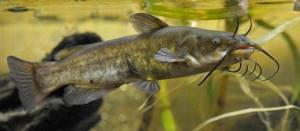
American catfish
(Ictalurus nebulosus) is a fish of the Ictaluridae family. American catfish live in overgrown, slow-moving and stagnant bodies of water with silty bottoms in North America. Introduced to Europe for breeding in ponds, spread throughout the water bodies of Belarus and Ukraine, and can be found in the western regions of Russia. The length of the American catfish reaches 1 meter. Very hardy to living conditions, can live in poor water where other fish species cannot live. Can burrow into the ground. Hunts and feeds at night. Unpretentious in food.

Appearance and features
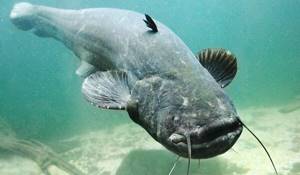
Photo: Catfish fish
Previously, giant catfish were caught in European rivers - their body length was up to 5 meters and their weight was up to 400 kilograms. These data inspire confidence, since the largest of the individuals registered according to all the rules is only slightly inferior - its weight turned out to be 306 kg. However, catfish grow throughout their lives, which means they reach such sizes very rarely: over the past decades, individuals heavier than 160 kg have not been caught - and even this weight is already huge for catfish. A fish weighing between 12-15 kg is considered an adult, and specimens heavier than 30 kg are very rarely found - this is a great success for the fisherman.
The head of the catfish is large relative to the body and looks as if flattened. The jaws are massive, but the teeth are very small - but there are a lot of them, and they are sharp. The eyes are small in comparison with the size of the head. A characteristic feature of a catfish is a mustache, two long and four short. The color of a catfish can vary greatly depending on where it lives and what time of year it is. Most often, its body is dark gray on top, and its belly is lighter. The fish may be light brown, greenish, sandy yellow or very dark. Often there are spots on the body.
The fins are usually darker than the rest of the body, they can be either very dark, close to black, or dark blue or dark green. Often, a catfish combines several shades at once, smoothly transitioning into each other - in young individuals these transitions are sharper, their colors are generally brighter than in adults, and even more so in older catfish.
The body of the catfish in front has a rounded shape, but the further towards the tail, the more it contracts. The tail is very strong and long - about half the entire length of the fish, the fins are generally quite powerful, but due to their size, catfish are inferior in speed and maneuverability to most other fish. There are no scales; instead, their skin is protected by a large amount of mucus - the sebaceous glands that produce it are actively working. Thanks to mucus, the delicate skin of the catfish remains intact, and its body glides more easily in the water.
What does catfish look like?
Catfish belong to the class of ray-finned fish, the catfish family. There are no scales on their body, and massive whiskers stand out at the end of their muzzle, for which they are sometimes called “barbels” or “river cats.”

The common catfish is a fish with a powerful body, covered with a thin layer of mucus for better gliding along the bottom. Its body shape is flattened, its head is flattened with a wide longitudinal mouth. Several dozen teeth, sharp as Occam's razor, are hidden inside the mouth. Above the upper lip grow two long, almost a third of the body, mustaches, which are an additional organ of touch for the blind river dweller. There are about 500 varieties of catfish, but they differ mainly in size and color, and thanks to their whiskers they always remain recognizable.
Where does catfish live?
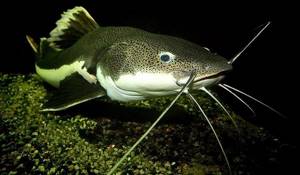
Photo: Catfish in the river
Found in most of Europe, including all of European Russia.
Catfish are found in the basins of such rivers as:
- Rhine;
- Loire;
- Seine;
- Ebro;
- Vistula;
- Danube;
- Dnieper;
- Volga;
- Kuban.
That is, the common catfish is distributed throughout almost all of Europe, with the exception of the lands adjacent to the Mediterranean Sea, namely most of the Iberian and Apennine peninsulas, Croatia, Greece, and almost all of Scandinavia.
Previously, it was not found at all in the Pyrenees and Apennines, but was introduced back in the 19th century into the basins of the Ebro and Po rivers, where it successfully reproduced. The same practice was used in many other cases, for example, catfish were not previously found in the rivers of France, the Netherlands and Belgium, Denmark - but after being introduced they took root in them.
Outside of Europe, they are found in the northern part of Asia Minor and Iran, as well as in Central Asia - the Amu Darya and Syr Darya basins. In Soviet times, catfish were released into Lake Balkhash, and they now thrive both in the lake itself and in the rivers of its basin.
Catfish are very fond of large, deep rivers and reach especially large sizes in them. Many large catfish are caught in the Volga and Ebro. They prefer warm waters, which is why they are not found in the rivers of the Northern Ocean basin east of the Urals. Although they usually live in fresh water, they are also capable of living in salt water - for example, in the Black Sea off the coast of Turkey, in the Baltic and Caspian seas.
All this applies to the common catfish, other representatives of this genus are also common in Asia to the east - for example, the Amur catfish lives in the rivers of China, Korea and Japan, and loves the Amur most of all, other species are found in South America, India, on the islands of Indonesia, and Africa.
Ordinary catfish live at the very bottom of the reservoir; they usually find a quiet place - a hole between snags, and settle there. They do not swim far from their favorite hole even during the hunt, but spend a significant part of the time right there. They rarely change their habitat and can even spend their entire lives in one place.
A change can be prompted by a lack of nutrition - then the catfish swims to where there is more prey, or by cloudiness of the water - they are very picky about its purity. Therefore, if the water becomes cloudy during floods, the catfish may go in search of a new place to live.
Now you know where catfish live. Let's see what the big fish eat.
Where is the catfish fish found?
Catfish are distributed throughout the world. They usually live in freshwater rivers, but one of the species - the channel one - can easily stay in salt water for a long time, where they swim in search of food or during the spawning period.
There are many of them in the basins of the Black, Azov and Aral Seas. There are catfish in varying quantities in all deep rivers of Russia, as well as other Eurasian countries. In America, there are mainly those species whose size is considered gigantic. It is interesting that some Americans, in response to the question of how long a catfish lives, answer that it is immortal. In Russia, such a belief is not widespread.
What does catfish eat?
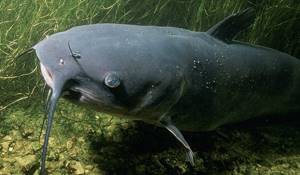
Photo: Catfish underwater
The diet of catfish is very diverse, it includes:
- fish;
- freshwater;
- birds;
- shellfish;
- insects;
- fry;
- larvae;
- worms;
- vegetation.
They often eat carrion, which is why there is a common misconception that they are limited to it - it is due to the fact that this large fish looks slow and clumsy. But she is more dexterous than she might seem and, although carrion actually makes up a significant part of the menu, catfish are not averse to eating live animals.
So, they hunt a wide variety of fish - they can swim straight into schools of small fish and, opening their mouths wide, eat dozens of them at once, or they can hunt large ones, like bream or pike perch. They can also dine on large amphibians such as frogs, newts or waterfowl - although they are rarely caught.
They can catch and eat pets caught in the water - cats or small dogs. There are even cases of attacks on calves caught in the water and, moreover, on people. It is difficult to say whether catfish are actually dangerous for humans; we only know for sure about people who were bitten by them and who accidentally stepped on their nest.
Young catfish feed mainly on the fry of other fish, aquatic insects, small crustaceans and larvae. As adults, they can also eat all of the above, but they do not specifically hunt for them - they simply open their mouths and suck all these small animals into it.
They hunt mainly at night, and can either search for prey at the very bottom or rise to the surface where they can find small fish. They remember where the old net was left and constantly check it to see if the fish are entangled there.
For the most part, they feed on fish, and during the hunt they can hide - usually the color of their skin blends with the river bottom, so the prey may not notice the hunter for a long time, until it ends up almost in his very mouth. If she managed to escape, the catfish does not pursue her for a long time.
They are distinguished by their gluttony: even taking into account their size, they eat a lot, especially in the spring, after nature comes to life and there is more prey - during the winter they manage to get pretty hungry. Here everything is eaten, even aquatic vegetation, although catfish usually prefer animal food.
Interesting fact: Whiskers are very important for catfish; they are used by the catfish to search for prey - even in complete darkness, with their help the catfish senses its approach. In addition, they can act as bait - hiding, he exposes them and lures small fish, which take them for prey.
What and how to catch catfish
How to catch catfish? Despite the opinion that large catfish prefer exclusively carrion, the diet of these predatory fish is dominated by fresh small fish, followed by crayfish, mice, other rodents, as well as birds and larger animals, which depends on the condition of the catfish itself. It chooses prey on its own... But, of course, a catfish will never refuse even slightly rotten fish, which is predetermined by nature. After all, he is one of many underwater orderlies who process rot and save waters from pollution and disease. A catfish will not swim past a rotten chicken lying on the bottom. It is clear that chickens rarely fall to the bottom by themselves. Unless it was to drown himself... And, most likely, the chicken was placed on the predator by an experienced fisherman, hiding in it a strong large tee or a powerful single hook. In the Astrakhan region, a good bait for catfish is a shell. You can catch some pretty good fish with it:
Video of fishing for catfish using kwok. Huge catfish about 35 kg
Features of character and lifestyle
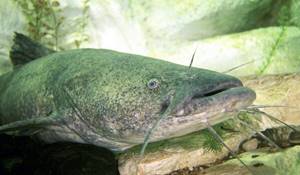
Photo: Big catfish
Catfish are homebodies and loners - they live for a long time in the quiet hole they like and do not want to let anyone near it. But this applies to adult individuals - just as fry stay in schools, so slightly grown catfish remain in them for the first years of life. If there is a lot of food, then they can stay together until the age of 3-4 years, then they have to disperse because each fish needs a lot to feed, and therefore each adult catfish must occupy its own territory, from which it can feed freely.
Catfish are active at night or at dawn - the latter applies primarily to young individuals who prefer to feed in shallow water near the shore. During the day, catfish prefer to rest in their den. If the weather is very warm, they can get out of the holes during the day and swim slowly, enjoying the sun.
They love warm and clean water. When it rains heavily and the water becomes cloudy, they get out of the den and stay near the surface, where it is cleaner. Catfish swim to the top even before a thunderstorm - they leave smooth traces behind them, different from those that mark the movement of smaller fish; experienced fishermen also know the splash when they move well and can distinguish it from that made by other fish. Fishermen often use the catfish’s good sense of smell by throwing food waste into the water and adding something freshly fried over a fire. The strong smell attracts catfish, and they rise from their depths to see what is coming from it.
In winter, their activity subsides: they gather in flocks of 5-10 individuals and lie down in wintering pits. At this time they feed very rarely, spending most of the time motionless, falling into a kind of hibernation. By spring, they lose most of the fat accumulated during the warm period, but as soon as it gets warmer, they begin to actively eat off again.
Catfish live for quite a long time - 30-60 years, and the oldest and largest specimens caught were 70-80 years old. With age, the catfish becomes slower, and it requires more and more food; instead of actively hunting, it begins to simply swim with its mouth open, trying to suck in living creatures - it spends more and more time feeding and it becomes more difficult for it to feed itself.
Catfish in cooking
Catfish is very useful for losing weight. Meat contains substances and elements that speed up metabolism. This characteristic has a beneficial effect on the process of losing weight.

The burning of extra pounds occurs due to easy digestion and rapid digestibility of the pulp. But fried meat in oil or fat can cause harm. To eat fish while losing weight, you need to steam it, simply boil it, make soup, and salads.
When choosing a recipe, it is worth considering some features. There is no need to use large individuals. They have tough flesh, and the swampy smell is almost impossible to remove.
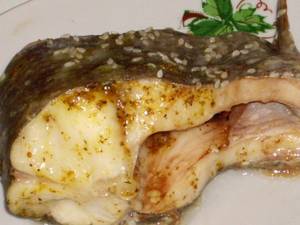
The meat is fatty, but it contains few calories. Fish cooked in a double boiler is indicated for patients with diabetes and people diagnosed with obesity. Catfish meat contains little connective tissue, so it is easily digested and very healthy for children.
The product is also necessary for athletes and people who have calcium deficiency. The pulp has a positive effect on the skeletal system, prevents brittleness and hair loss, and strengthens the legs.
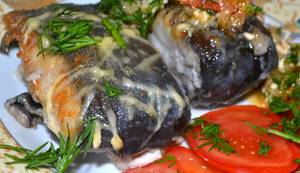
There are many options for preparing catfish dishes. Many recipes require little time and ingredients, and the results are beyond praise. They like to bake the river inhabitant in the oven with vegetables - potatoes, zucchini, cabbage, carrots. It is important not to overcook the food in the oven so that it does not become dry. Experts recommend not removing the skin when baking, so the catfish will not lose its juiciness.
You can also get delicious meat if you bake it over a fire. If you pre-marinate it, you will get a tasty, juicy kebab or steak. What cooking options are there:
- in a slow cooker with gravy, sour cream;
- in the oven with vegetables and other seafood;
- in a steamer with rice, green beans;
- Fry in a frying pan and make cutlets.
Minced catfish makes tender, healthy and nutritious dishes. You can use it to make cutlets, meatballs in sauce, potato pancakes with meat filling, and rolls. The pulp is also used in cooking soups: kharcho, fish soup, cabbage soup, and solyanka.

To fight off the characteristic smell of mud, you need to familiarize yourself with some tips that will help remove the unpleasant odor:
- First you need to cut the fish, wash it and cut it into pieces or steaks.
- The finished pulp is poured with a small amount of lemon juice or dry white wine. Let it brew for 20 minutes.
- The pieces are washed under running water. Next, they are immersed in milk and allowed to stand for 2-3 hours.
The second option is to clean the catfish and cut it into the necessary pieces. Then they are covered with salt and left for 1 hour in the refrigerator. Next, wash in water with acetic acid.
Social structure and reproduction
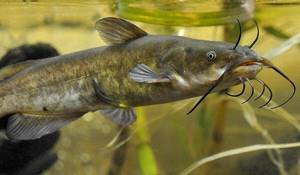
Photo: Little catfish
Catfish begin spawning when the water warms up enough - they require a temperature of 16-18°C. Depending on the habitat, this can occur from early May to early July. Before spawning, the male builds a nest - he finds a convenient place in shallow water, digs a hole in the sand, and then the female lays eggs there.
On average, she lays 30,000 eggs per kilogram of mass - that is, if she weighs 25 kg, then there will be 750,000 eggs! Of course, only a small part of them will become fry, and even fewer will survive to adulthood - but catfish reproduce quite efficiently. This is shown by the practice of releasing them into rivers where they were not previously found: if the habitat suits them, then the initially small population of catfish after just a few decades grows greatly, and after 50-70 years there is no longer any difference with the rivers where they were found historically - in new ones there are just as many of them.
After spawning, the female swims away - she is no longer interested in the fate of the offspring, and all concerns remain with the male. He is almost constantly at the nest and is engaged in protecting the eggs, and also constantly brings fresh water saturated with oxygen to the nest - this is necessary for the better development of the offspring. After 10 days, the fry appear - they are approximately 6-8 millimeters in length and resemble tadpoles. After hatching, they attach themselves to the walls of the nest and remain in this position for about a week and a half, feeding from the yolk sac.
Only then do they begin to swim and look for food - but at first they do not move away from the nest. All this time, the fry are completely defenseless, so the male stays with them and protects them from predators. After four weeks, they disperse - young catfish are divided into several groups and stay together for another year or two, and sometimes longer.
Cooking catfish
Catfish meat has high palatability, it is tasty, tender and fatty, which is why catfish is a desirable catch for any fisherman. In the old days, people used catfish swim bladders and skin. Glue was made from bubbles, and “glass” for windows was made from catfish skin.
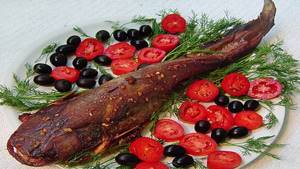
Catfish meat is highly nutritious and caloric. 100 grams of catfish meat contains 115 kilocalories. Catfish meat contains a fairly large amount of fat, especially in the tail part, but is considered dietary. Catfish meat has virtually no bones; even older people and children can eat it.

Many ways of preparing the tender and fatty catfish meat have been invented. It is fried, fish soup is made from it, filling for pies, cutlets is made, baked with vegetables and stewed. Catfish can be salted and dried.
Fried catfish

Fried catfish is a simple and very tasty dish. The catfish is gutted and cut into pieces, which can be steak-shaped or simply large pieces of meat. The chopped meat is rubbed with salt. Prepare the batter by mixing a chicken egg with sour cream, adding flour and mixing thoroughly. Cut pieces of catfish meat are dipped in batter and placed on a preheated frying pan. The pieces of meat are fried for five minutes on each side. Fried catfish is served with boiled rice or potatoes.
Catfish baked in the oven

Small catfish weighing up to 3 kg are well suited for baking. The catfish is gutted and washed. Deep cuts are made in the carcass, the whole thing is poured with freshly squeezed lemon juice and left to marinate for 20 minutes. After this, the catfish carcass is rubbed with salt and pepper and sent to the oven. Cooking time is 30-40 minutes. Baked catfish can be decorated with cranberries or lingonberries. Catfish baked in the oven is sprinkled with herbs and served with a side dish, which can be boiled rice or potatoes.
Natural enemies of catfish
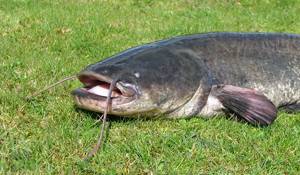
Photo: Catfish fish
The only enemy of adult catfish is humans. Not a single river fish can compare with them in size, much less attack them, so they live in the open spaces of the water quite freely and suffer only from human activity. At the same time, adult catfish bite less readily, but still the main cause of their mortality is fishing.
Underwater hunting for catfish is much less common, in which hunters go down with scuba gear - this way you can catch even the largest of them. But many adult catfish still manage to successfully live to old age. It is more difficult for young fish to do this, mainly because they bite much more readily and are caught more often.
But even young catfish are not threatened by anyone except humans. Other predatory fish can be a threat to them only while they are still very young; they also often eat eggs or fry. It can be pike, burbot, asp, and almost any other river fish. But juvenile catfish are usually protected by an adult male.
Interesting fact: The electric catfish is one of the most interesting catfishes. It lives in Africa and is capable of generating strong electric currents - up to 350 volts, thanks to organs located under the skin that cover most of its body. Using electricity, this catfish stuns its victims and protects itself from enemies.
Equipment for catching catfish from a boat
Catfish can be effectively caught from a boat using trolling. Trolling gear allows you to quickly fish large areas of a reservoir and includes:
- casting rod with dough up to 100 g;
- power multiplier coil;
- braided cord 0.16–0.18 mm thick;
- fluorocarbon leader with a diameter of 0.3 mm;
- wobbler with a diving depth of 6–12 m.
The “braid” is directly tied to the leash using a counter knot, which gives the rig additional strength. You should not use thick monofilament fishing line when trolling, since such monofilament will not allow the wobbler to go deep to the working depth. In addition, thick monofilament will disrupt the performance of the bait.
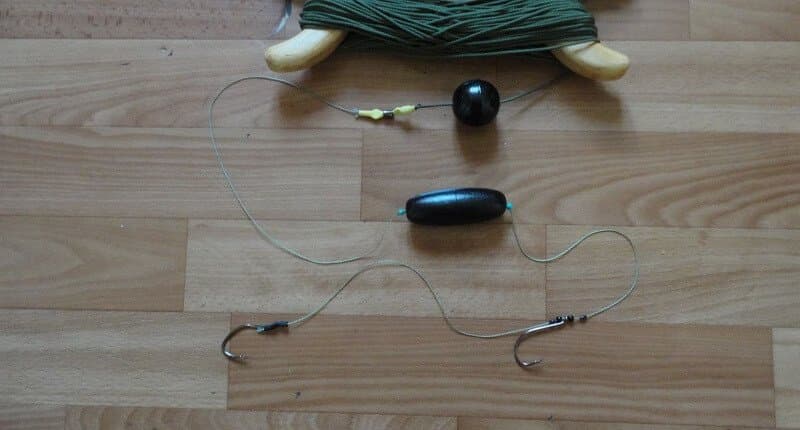
Catfish bait
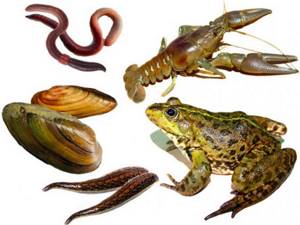
Catfish are not fussy fish; they eat whatever they catch. You can catch a mustachioed giant using bait such as:
- a bunch of worms;
- frogs;
- fried birds;
- shrimp;
- crayfish;
- any meat or offal;
- fish pieces;
- grasshoppers and mole crickets;
- shellfish;
- leeches.
There is a strong opinion that catfish loves rotten meat, although it will not refuse fresh meat.
Artificial baits for spinning fishing
There are many artificial baits for spinning; the list of them can take a very long time. But the most catchy ones for the mustachioed predator are wobblers, spinners and silicone.
Wobbler
floating wobblers - they are equipped with a blade and have an average diving depth. Great for the summer season, near the dams of huge rivers. After darkening, the barbels swim into shallow water, in places where small things accumulate.
They drive the wobblers in jerky movements, pausing so that the bait can float up. The barbel always bites when the wobbler starts moving again. The length of the wobblers should be 20 cm.
Rapala Countdown Magnum 22
Sinking - when the temperature drops in the fall, catfish move to deeper layers, and that’s where you need to look for them. The best bait at this time will be wobblers, sinking with a semi-passive game. Postings must be done slowly. Hunting at this time:
- rivers - in whirlpools, next to the harbor.
- lakes - in deep-sea places.
A very good wobbler from Rapala Magnum .
The fish is inactive at this time, and therefore you need to give it a little rest by stopping the bait.
Silicone
Large edible and inedible silicone fish (10-25 cm) are suitable for spinning, especially in spring and autumn. At this time it lies in the bottom layers.
On the river, silicone is used in whirlpools near dams, at the confluence of two rivers, etc.
In lakes - at depth, near catfish shelters. Barbel has a good sense of smell, so the fish should not have a pungent synthetic smell. You can treat it with purchased flavorings, or keep it in a bag with fish for a couple of days.
Spoon
Effzett
Barbels are very tempted by the loud sound of bait. For night hunting, a heavy spoon is suitable, for example, a two-layer one - Effzett . It makes noise when lowering and a clicking sound when moving.
To explore a place and fish, you can throw the bait into the same place 20-30 times without worrying about the noise it makes.
This individual bites on a noisy bait only after it has been repeatedly lowered into the water.
When using this wiring technique, you need to pay special attention to the speed of regaining control of the nozzle. Because when hunting for a lure, the bite can begin almost immediately after casting.
In order not to lose control of the bait, when casting you need to slow down the flight a little. This will ensure instant hooking when biting.
Geography of distribution and habitats of catfish
The common catfish is a heat-loving representative of the aquatic fauna, therefore in Russia it lives only in regions with a temperate and subtropical climate - in rivers and lakes of the warm sea basins: the Azov, Black, Caspian and Aral seas.
In the reservoirs of the Baltic Sea it is found much less frequently and does not grow to normal sizes. Another species close to the European catfish lives in the waterways of Siberia - the Amur catfish (Silurus asotus), which differs from its fellow in certain features, smaller growth and color.
The largest numbers of common catfish are observed in the lower reaches and deltas of rivers flowing in southern latitudes - the Volga, Dnieper, Ural, Don and Kuban. Catfish tolerate brackish water well; therefore, they also live in estuaries and slightly salted sea areas.
Not only for safety reasons and their large size, which does not allow catfish to feel normal in shallow water, but also because of the fear of light, these nocturnal predators settle in the deepest and shady places of reservoirs. For their homes, catfish choose holes equipped with shelter - flooded logs or sunken trees and snags. In shallow rivers, they can hide in beaver pits, under floating banks, in depressions in the bottom under steep banks and bridge piles.
Prefers silty or sandy soil, especially if it is shaded by floating plants: richia, duckweed and water fern. Until sunset, the catfish hides in its shelter, lying down and digesting the food obtained the day before, and only at dusk it goes hunting.
Techniques and tactics for catching catfish
Wiring parameters - measured, unhurried movements of the rod:
- The wobbler needs to be buried no more than 30-40 cm from the bottom.
- Jig fishing - take edible or inedible silicone fish and heavy spoons.
- When casting, they are caught with silicone baits and oscillating spoons.
- Trolling - diver wobblers.
In particularly intense currents, use spinning rods: test 60-150 or more.
In low currents and standing water:
- test - 30-80, heavy class;
- multiplier reel - 5500-6000;
- braid, with breaking load - 15-25 kg.
You can take any bait, for example : foam rubber, silicone fish, various kinds. They should be equipped with a 20-50 g weight at the front.
The principle of wiring is that the bait must pass the bottom in jerky movements.
Make several turns of the coil, followed by a long pause - 10-15 seconds. The bite is a bit like a hook. Only after 7 seconds will the catfish come to its senses and begin to resist. When fishing with a spoon (spoon), the game drags on, it is sluggish and unpredictable, sometimes it needs to be interrupted for 4-7 seconds.
Sometimes a spinner may also be of interest. In small lakes and rivers you can catch it using oscillating spoons. In large areas, catchable ones are deep wobblers with a dive of up to 5 m. At night, use baits moving near the surface of the water.
Aquarium catfish and catfish
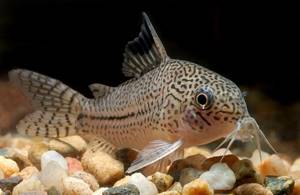
About two thousand species of catfish inhabit the fresh waters of the world. These are one of the oldest fish on the planet, their fossil remains were discovered in sediments of the late Cretaceous period (70 million years ago).
One of the main signs is the absence of scales, often replaced by bone plates. Catfish lead a bottom nocturnal or twilight lifestyle. There are also predators among them, but most species prefer detritus, plant food and benthic invertebrates. Aquarists keep up to 800 species of catfish, not counting hybrid forms. Normal aquarium conditions are suitable for keeping: hardness 6-12°, temperature 22-26 °C. acidity is neutral, with slight deviations in one direction or another. Thanks to cutaneous respiration, or the ability to breathe atmospheric air, most catfish are not demanding of oxygen. Haplosternums, for example, swallow air, it enters the intestine and is absorbed into the blood through a dense network of capillaries.
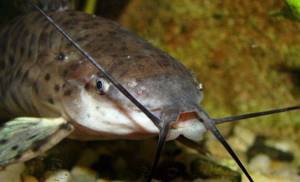
Armored, or callichthid, catfish are represented by almost one and a half hundred species, common in the waters of South America. These are typically omnivorous bottom-dwelling fish. Their body is quite tall, triangular in cross section, covered with bone plates arranged in two parallel rows, reminiscent of parquet. The small lower mouth is surrounded by three pairs of antennae, which help in searching for food. Males are slimmer than females and have more developed dorsal and pectoral fins. Callichthids get along well with any fish, simply ignoring them completely. They themselves are unattractive prey even for large predators. In aquariums with armored catfish that constantly dig at the bottom, it is necessary to arrange efficient water filtration, cover the bottom with pebbles, and plant plants with a strong root system. The impetus for the spawning of callicht catfish is a drop in atmospheric pressure, the addition of soft, cooled water by five degrees and the presence of a substrate for laying eggs. The incubation period is 5-8 days at a temperature of 25 °C. The starting norms are rotifers, microworms, brine shrimp and mixed feed.
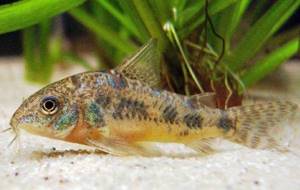
Of the armored catfishes, the most common genera among aquarists are Corydoras and Hoplosternum . The genus Corydoras includes the golden catfish (C. aeneus) and the speckled catfish (C. paleatus). The body of the Corydoras is short and ridged. The abdomen is flat, the back is convex. The male's dorsal fin is pointed. The main color of the speckled catfish is olive with a metallic sheen, the back is darker, and the belly is yellow-orange. Irregular dark spots are scattered throughout the body. The golden catfish has a wide shiny dark green stripe running along its entire body. In the anterior third above it there is a narrow golden one. The head and back are dark brown. Both species have albino forms. The speckled catfish is an old-timer in aquariums. Its first breeding dates back to 1878.
Hybrids of golden and speckled catfish are widespread in aquariums, as well as their hybrids with Corydoras Rabo, Schwartz and black-striped Bond. The fish grow up to 7 centimeters in length, females are larger than males. Vessels with a volume of at least 80 liters are suitable for spawning. The fish are placed in a spawning tank in a group, with a predominance of males. The water temperature is slightly above 20 °C. The composition does not play a role. The female lays her eggs in the pelvic fins folded together, where they are fertilized by the males, and glues them to a solid substrate. This could be a leaf of a plant or glass of an aquarium. If spawning took place in a community aquarium, the eggs can be carefully removed with a razor and transferred to a separate vessel for incubation. The best starter food is brine shrimp. In addition to those mentioned, at least three dozen more Corydoras can be found in aquariums. The genus Hoplosternum is much less rich in species. But one of them is perhaps the most famous aquarium catfish.
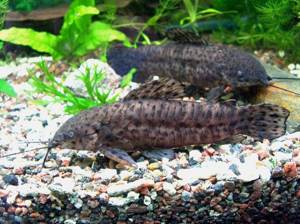
Thoracatum ( Hoplosternum thoracatum) from Eastern Brazil has been bred in Russia since 1910. This is a fish with a long round body, reaching 18 centimeters in length. The body is covered with two rows of plates, like the Corydoras. At the highest point of the back there is a rather large dorsal fin. The color of the catfish is brownish-brown, with irregular dark spots. There is a black color option. In males, the anterior ray of the pectoral fin is greatly thickened and turned into a powerful bony spine of orange-bloody color. Torakatums build foam nests under floating objects and plant leaves, releasing air bubbles not with their mouths, like labyrinths, but from under the gill covers. In the spawning area, the easiest way is to use a foam raft the size of a school notebook. During spawning, a female can spawn up to 1000 eggs. The male is left to guard the nest, but the raft with the eggs stuck to it can be transferred to a separate vessel. It is advisable to carry out prophylaxis against fungi and add methylene blue or trypaflavin to the water. Two days after hatching, the juveniles begin to take artemia.

The beige hoplosternum ( Hoplosternum litorale) is not inferior in size to the previous species. The color is beige-olive, sometimes gray with a greenish tint. The body is torpedo-shaped. These catfish build nests in the form of a large and high cap of foam mixed with scraps of plants. Both species of Hoplosternum are unpretentious, peaceful fish that love darkness. In aquariums, shelters made of driftwood and stones and shaded areas of the bottom are desirable. During maintenance, water parameters do not play a role. In spawning grounds, it is necessary to add soft water and raise the temperature to 24 °C.
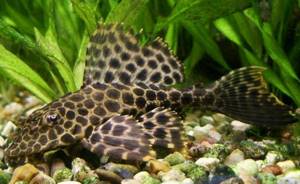
The family of chain catfish is not deprived of the attention of either experienced aquarists or beginners. A distinctive feature of these bottom-dwelling fish is a strongly elongated or flattened body, completely covered with multifaceted bony plates, and a well-developed oral sucker with tubercles and outgrowths for scraping off algal formations. Males are larger, brighter and slimmer than females. In adulthood, they have numerous outgrowths on their heads that resemble plant roots - tentacles. In females they are much less pronounced. The main food of loricariid catfish is plant-based, but they do not refuse bloodworms, tubifex, fillets of sea fish and sinking feed. The eggs are deposited in ceramic or glass tubes. During the entire incubation period of the eggs, 6-10 days, the male sits in the tube, covering the eggs with his body. If spawning occurred in a common aquarium, the tube, along with the male and the eggs, is transferred to a separate container, simply closing the ends with your hands. When the fry swims, the male is removed, and the fry is fed with brine shrimp, mixed feed or algae paste.
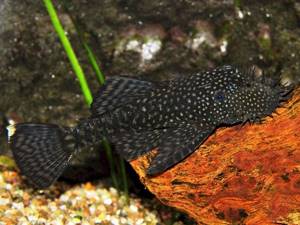
Ancistrus (Ancistrus dolichopterus) - from the waters of Brazil. The flat body is painted in dark colors with light spots. The abdomen is light. The large dorsal fin resembles a flag. The fish grow in good conditions up to 14 cm. They swim ineptly and reluctantly. They spend most of their time clinging to the glass of the aquarium or plant leaves and scraping off algae. Activated in the dark and when atmospheric pressure drops. Ancistrus are quite suitable for the conditions of a community aquarium, to the other inhabitants of which they do not pay the slightest attention. The female lays 50-100 sticky, oblong, bright orange eggs that resemble small barberries. The water in the spawning tank and nursery aquarium needs to be slightly acidic, pH=6.0-6.5, temperature 26 °C. The fry begins to take food 6-8 days after hatching.
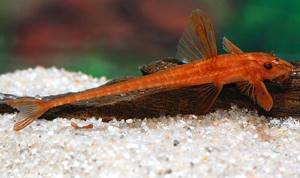
Loricaria (Rineloricaria sp. “Red”) is one of a large family of fish, most commonly known as “red loricaria.” The body is elongated, highly elongated, thin. The length of an adult fish reaches 12 cm. The color is red, of various shades. The male is slimmer and has a brush of bristles on his pectoral fins. Loricarias are absolutely peaceful fish. They lead a modest lifestyle, often hiding so that it is impossible to find them in the aquarium. They take any food from the bottom. Spawning is seasonal - in winter. It flows like ancistrus. Suitable tube diameter is about 30 mm. Swimming fry look like scraps of threads 7 mm long. They are very sensitive to water contamination with organic matter. In a nursery aquarium, a filter with activated carbon and a daily complete replacement of water with fresh water of the same composition and temperature are required. Settled tap water, passed through a filter, is suitable. The fry grows quickly and soon ceases to react painfully to pollution. When installing filters in aquariums with chain-linked catfish, and especially with their juveniles, it is necessary to prevent fish from getting into the structure. They tend to look for cracks and holes and crawl into them. Once caught in the filter, catfish usually die.
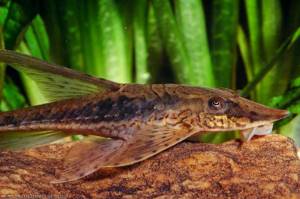
Sturisoma panamense is a catfish with a very thin and long body. The snout is sharp, the pectoral and dorsal fins are large, in the shape of a sharp triangle. It grows up to 30 cm, while being almost a complete vegetarian. He is picky about food - he needs algae tablets, lettuce, even cucumbers. Does not tolerate pollution. The eggs are laid in a tube.

Brocade pterygoplichthys (Pterygoplichthys gibbiceps) . Luxurious catfish from the river. Orinoco. Black or dark brown spots - brocade - are evenly scattered over the light body. The dorsal fin is large and high, sail-shaped. The mouth is a large, strong sucker. Swims poorly and reluctantly. It eats fouling and scrapes wood snags that need to be provided to it. But he doesn’t refuse bloodworms either. Water hardness varies widely, temperature from 23 to 30 °C. The "brocade catfish" has become very fashionable in recent years, but often becomes a problem for beginners. On sale there are usually juveniles measuring 5-7 cm. When purchasing a catfish, they often do not know that it can grow up to 30-35 cm. In a small aquarium, pterygoplicht becomes a “bull in a china shop”, and in a large aquarium, with slow large fish, for example discus fish, trying to attach to them. Catfish are probably attracted to the mucus that covers their body. As a result, the scales are damaged and ulcers may occur. Pterygoplichts does not pay attention to small fish. We can recommend catfish from the genus Hystomus, similar to Pterygoplichthas, which lack this disadvantage and do not grow so quickly.

Hypostomus has a body shape that strongly resembles Pterygoplichthas. The dorsal fin is smaller, the color is brown, reddish or reddish. Imported under the names Hypostomus sp., Hypostomus spotted, Hypostomus red, Hypostomus albino and Hypostomus watawata. The last name seems closest to the truth. The conditions of detention are no different from the brocade catfish. Watawata from Peru is the most useful inhabitant of the aquarium. A convinced vegetarian, not paying attention to bloodworms, is constantly busy cleaning the aquarium of algae. To perform ideal continuous cleaning in a two-hundred-liter container, one catfish is enough. In my pet store, there is always one Watawata catfish in each aquarium. If the catfish does not have enough pasture, it is necessary to feed it with plant food.
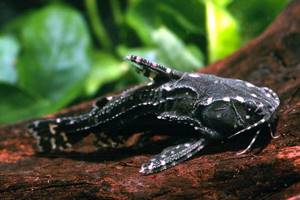
Armored catfish are covered with a durable bony shell, which is absent on the flat belly. Crepuscular, solitary fish looking for food at the bottom. The dorsal and pectoral fins are equipped with strong, jagged spines. Be careful: catfish easily get entangled in the net, and a pricked finger hurts for a long time. If you pick up a catfish in your hands, it makes a loud squeaking noise. Omnivores, but need at least a third of plant food. Withstands a wide range of water hardness, acidity and temperature. They are indifferent to the oxygen content in water and can swallow atmospheric air. Aquariums most often contain agamix (Agamyxis flavopictus) - black in color, with light spots, and platidor (Platydoras costatus), which has yellow stripes on its dark brown body - two on the sides and one on the ridge. Both fish have a short massive body and a large head with not very long whiskers. They grow up to 12-15 cm. They do not pay attention to their neighbors, busy with their own affairs. They require not too coarse gravel at the bottom and shelters made of ceramics or driftwood. The content is not complicated. Breeding is only available to experienced aquarists.
Killer whales are fast, sociable, diurnal catfish that stay in the water column. They are not very predatory and can be kept in a species aquarium with other fish. The skin is bare, without bony plates, the first ray of the dorsal fin is transformed into a hard spine. Water parameters can vary widely. Omnivorous, but live food is preferred. Males are smaller and slimmer.
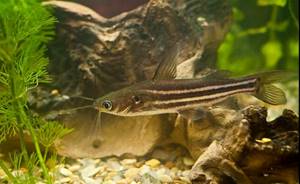
The most popular killer whale is Mystus tengara . It would be more correct to call the catfish “tengara”, since several other mistuses are common, but the name has taken root in the aquarium hobby. The body is elongated, silver-gray, with a bluish tint and light longitudinal stripes. The eyes are large, with contrasting “earrings” behind the gill covers. The snout has four pairs of rather long antennae. Length up to 12 cm. Mistus is a “shock” fish. If there is a sudden change in conditions, for example during a transplant, he “faints” and may die. It doesn’t matter whether the new conditions are worse or better, the mystus reacts only to their change. Before planting newly acquired fish in the aquarium, you need to smoothly equalize the water parameters. The easiest way is to add water from the aquarium intended for it to the water in which the catfish arrived, using a thin tube.
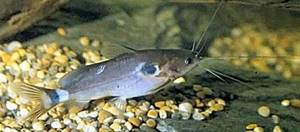
The reddish killer whale ( Mystus micracantus) , similar in shape to the Mystus, but colored in pink-red tones, with large dark spots behind the gill covers and a dark band on the caudal peduncle, and the Siamese killer whale (Leiocassis siamensis), dark brown, with wide yellow transverse stripes, like a bumblebee, are kept less frequently. Caring for them is not difficult, breeding is not mastered.
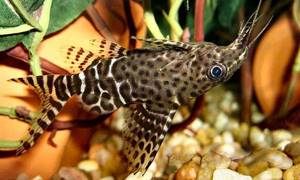
Sinodontis is a genus of African catfish from the rivers Zaire, Nile, Niger, Zambezi and others. About 10-15 years ago they suddenly entered Russian aquarium fashion. Many of them are peaceful and calm fish, quite large in size. The body is torpedo-shaped, triangular in cross-section, with a large, wide head. Three pairs of long branched mustaches. The color is very variable - from ash-gray to almost black with dark and light spots. All types of synodonts are able to swim belly up, combing the surface of the water with fluffy mustaches and collecting insects that have fallen into the water. For the skinwalker (S. nigriventris), this method of swimming has become the main one. Keeping synodonts is not a problem. The water reaction is neutral, the temperature is 22-26 ° C, but it is advisable to increase the hardness to 18 °. Catfish become active at night, eating bloodworms and other food prepared in advance for them at the bottom. Reproduction of synodonts is very difficult. Only from one species (Synodontis spec.) is it possible to obtain offspring in the traditional way, and even then not always. The most common are: Angelic synodont, (S.angelicus) - black, with white polka dots. Contrary to its name, it attacks small fish and is only suitable for keeping with cichlids or other fish that can fend for themselves. Size up to 20 cm, usually no more than 15. Changeling (S. nigriventris) is a peaceful catfish up to 6 cm long. Suitable for any aquarium. The color is gray, with streaks, but recently a pure black color option has appeared. The cuckoo (S. multipunctatus) is not a bad companion in a community aquarium. The color is gray-yellow, with dark round spots. Drops its eggs on spawning African cichlids.
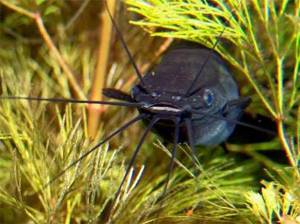
The sacbranch catfish (Heteropneustes fossilis) is the only species in the family. The body of this catfish is cylindrical, elongated, and the color is black-blue or brown. Sometimes with two golden longitudinal lines. There are also albinos. On the jaws there are 4 pairs of long, dark whiskers directed forward. Size up to 30 cm. Males are brighter and slimmer than females. During spawning, the coloration of the spawners intensifies and spots appear on the body. The catfish is attractive not because of its color, but because of its unusual shape. These catfish breathe atmospheric air. From the gill cavity to the tail itself, two air sacs extend, acting as lungs. In nature, this adaptation allows catfish to wait out drought, remaining almost without water in semi-dried mud. They can be kept in normal aquarium conditions. During the day, catfish prefer to hide in shelters under stones, snags or plant roots. They treat other inhabitants with indifference, but they can thoroughly scare away other fish trying to take their favorite place on the bottom. In order to avoid conflicts, it is better not to keep other bottom-dwelling species in an aquarium with them. The spawning ground requires sandy soil, onto which up to 5,000 eggs are laid after vigorous mating games. The fry swims on the seventh day, it is easily fed with compound feed and grows quickly.
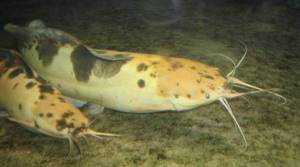
Clarias angolensis (Clarias angolensis) . When young, it is very similar to the sacbranch catfish. The main difference is the dorsal fin, which extends almost along the entire body. The natural color is brown, with small specks. The marble form often goes on sale. The body is light yellow with dark brown large “marbled” spots. This is a voracious predator for a large species aquarium. It can grow as thick and as long as a teenager's arm. The content is very simple - almost any water parameters. Omnivorous and very voracious.
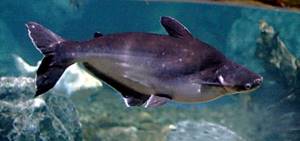
Pangasius (Pangasius hypophthalmus; syn. P. sutchii and P. sp.) . Catfish from Thailand are very popular in aquariums around the world. It has been imported to Russia not very long ago and is still little known among newcomers. The body is shark-shaped, bluish-silver, with a dark longitudinal stripe. The back is dark. A flock of pangasius rushes feverishly around the aquarium, adhering to the middle layers of water, greatly enlivening the underwater landscape. Quite a peaceful species, suitable for keeping with not too small species. He may panic and “faint,” but quickly comes to his senses. Gluttonous, grows quickly reaching 20 cm. Any food, temperature 23-27 “C, neutral water with slight deviations.

Glass catfish, or ghost catfish (Kryptopterus bicirrhis) . Active during the day, completely peaceful catfish with a transparent body. Internal organs and skeleton are visible through transparent muscles and skin. Lives in average aquarium conditions, but only in a flock. Single individuals die quickly. Keep only with peaceful neighbors such as small characins or livebearers. Easily catches infection from sick fish. At the same time, the transparent body of the catfish becomes cloudy. Thickets of plants are needed as shelters. A small regular water change is needed. Does not tolerate dirt well. It stays in the middle layers of water, swims slowly, “carefully”. Live and dry food is suitable. It grows no larger than 10 cm.
More interesting articles on the topic:
Cichlids in an aquarium
The Cichlid family is included in the order Perciformes. Indeed, in the tropics there are many
Genus Brachydanio
The genus Brachydanio inhabits small bodies of water in India, Sumatra, Burma and the Ma Peninsula
Killifish
Killifish is the generally accepted international name for spawning fish. Or,
Floating plants in an aquarium
Riccia fluitans - liver moss, common in water bodies
Turbellaria (ciliary worms) - parasites of aquarium fish
Causes: Triciadida can cause damage in aquariums primarily &
Barbs in the aquarium
The genus Barbus, or Puntius, includes many wonderful aquarium fish. Is not



